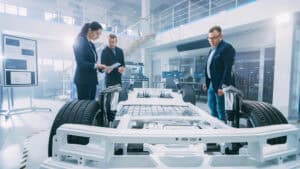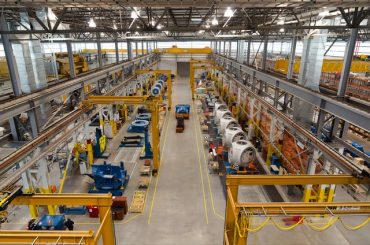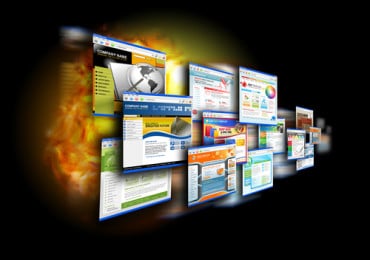
Automakers are turning to digital twins and other technologies to overcome the complexities of electric vehicle (EV) design and manufacturing.
Countries around the world are implementing regulations and mandates to promote the adoption of electric vehicles (EVs). And many car buyers want EVs to do their part in reducing emissions and becoming more environmentally friendly. As a result, automakers are bringing or planning to bring EVs to market.
However, the shift to EVs brings significant changes to all aspects of auto manufacturing, including design, development, production, and supply chains. Vehicle architecture, crash safety, electrical systems, and software development all need to be reimagined for EVs.
RTInsights recently sat down with Nand Kochhar, Vice President of Automotive and Transportation Industry Strategy with Siemens Digital Industry Software, at Siemens to talk about these industry changes, the challenges they bring, what technologies can enable the change, and how Siemens can help.
Here is a summary of our conversation.
RTInsights: What are the big-picture issues and factors that make EVs such an important market for auto manufacturers?
Kochhar: There are several trends in the industry, starting with consumer trends. Consumers are becoming more environmentally conscious and greener. That drives a demand for zero emissions or reduced emissions autos. And that translates into a growing demand to produce electric vehicles or switch the powertrains from internal combustion engines and diesels into electrified products. The end result doesn’t have to be an all-electric vehicle. It could be plug-in hybrid vehicles or pure hybrid vehicles. The goal is to become more environmentally friendly from an emissions standpoint.
Now obviously all over the globe countries have approached this from many different angles. Some have put the mandates in place where, by a certain year, they will ban the internal combustion engines. Others have not been as strict. And still others are bringing in regulations.
We see that happening all over the globe, where different people have different sustainability goals and different views on the impact of climate change.
These are big factors that are driving a change in the automotive industry. Automotive manufacturing is addressing that change by becoming more sustainable as a business with a change in product offerings for the consumer.
RTInsights: How do EVs change all aspects of auto manufacturing (including design, development, production, supply chain, etc.)?
Kochhar: For over a hundred years, the industry has been building vehicles and developing technologies around powertrain offerings with gas or diesel engines and drive trains. So, bringing in EVs, battery-electric, or any other modes of electrification (and it could be hydrogen in the near future) brings a huge mega shift in design, development, manufacturing, and other elements of the industry.
Let’s look at electric vehicles alone. You’re bringing a huge battery into the vehicle to be packaged versus an engine in the engine compartment up front. That changes everything from vehicle architecture, the packaging, and more.
Think about that from a design perspective. Everything is different compared to gas-powered cars with internal combustion engines. When you’re designing cars for a front-end crash or side impact, you don’t have that huge engine. The whole mode of safety crash changes. So, auto manufacturers have to take that into account.
There are similarly large changes to the development process. Again, by bringing in battery electric vehicles, you have a lot more electronics in there and a completely new electrical architecture. The power demand on your battery systems, and on what we call the battery management systems, changes significantly. The large batteries in electric vehicles bring new challenges from a thermal events perspective due to the heat generated by the batteries. So, the cooling systems now have to take that into account. It’s not only just the heat generation but the amount of software that comes with it. So, you can see that in the development process, everything is shifting.
When you get into production, again, you’ve got high voltage stuff in the vehicles now that needs to be managed carefully. In the production processes, end-of-line testing will be different from that for internal combustion engines.
There are also major supply chain changes. In the past, automakers had a supply chain that covered traditional automotive, exhaust systems, and fuel systems. With electric vehicles, you don’t need many of those traditional suppliers, and you need different suppliers. This shift is not only for the OEMs but also for the entire ecosystem. All those suppliers that were building powertrains for internal combustion engines have to shift their business models and have to learn how to design E-motors, power electronics for their systems, and more.
On the positive side, you could say in electric vehicles there are fewer parts as compared to the traditional automotive and the supply chain is a lot easier to manage in a way. However, being new, there’s a cost differential whether it is in batteries or in electronics.
In a way, all this newness makes you feel like you are defining the entire automotive business and development processes from scratch. That’s in addition to some pure electric vehicle startup companies that do not have a legacy of building internal combustion engines. They, too, are starting from scratch. In some cases, the startups end up gaining a positive advantage versus additional challenges for existing OEMs that are shifting from their 100 years or 40 years of history to offering electrified products.
See also: EV Automakers Must Prepare for the Technology Arms Race
RTInsights: What challenges do the automakers face when undertaking these changes?
Kochhar: One of the biggest challenges is in electric vehicle architecture. Not only has every physical architectural aspect, from crash design to space to packaging, changed, but so has electrical architecture. Automakers must switch from today’s non-electric platform to different electrical architectures.
So, you’ve got electrical architectures changing on top of vehicle architectures, and then within those electrical architectures, you have to take care of the networking architecture. All the pieces have to come together. Again, those are the challenges when vehicle OEMs are taking on these new vehicles. They have to come out of the current platforms and into EV platforms, and it becomes challenging to shift because you still have the constraints of the old architectures.

That’s how a lot of companies are starting their journey with the current vehicle architectures, building new EV architectures into them. Then, they look into having a brand-new architecture that includes new electrical networks and software architectures. Those all are big challenges.
The automotive business has been a very complex business to begin with, but now you are adding a lot of new things, new powertrains, new EV architectures, that makes it even more complex. The complexity goes through the roof and now it becomes a challenge how to handle that complexity.
Solutions for those challenges need to work in this multi-domain engineering environment. So, it’s no longer just mechanical systems coming together or a few electrical things, so-called electro-mechanical things coming together, but now you’re very heavy on electronics, semiconductors, software, embedded software, and application software along with the mechanical traditional stuff you’ve been doing.
The ability to handle this, what we call the multi-domain for delivering cross-attribute optimization, becomes a huge challenge.
RTInsights: What technologies can help address these challenges?
Kochhar: In a very broad sense, digital transformation technologies are building up to a digital twin where you’re bringing together your real or physical environment with the digital so that teams can make their decisions in a closed-loop fashion. Those are the best technologies to help manage this complexity and deliver insights for making all those decisions in a very cost-effective manner. Those are some of the key enablers. They allow you to bring not only electrical electronics and mechanical together but the software simulations as well.
That multi-domain aspect helps because when you’re bringing in batteries, you also need to account for electrochemical behaviors in the system simulations. All these things need to come together, and those technologies can really help with component systems, subsystem level technologies and with integrating all those together to do simulations and analysis, delivered through digital twins.
Now obviously we’ve got the traditional technologies that are used for balancing noise, vibration, power consumption, and thermal characteristics. But now you have a lot of new components with electric vehicles. You’ve got E-motors and power electronics. We’ve got solutions for each one of these sub-segments of subsystems. And we bring them together through the supply chain.
Other important technologies include access to great computing power. There’s the ability to serve software over the air. And, naturally, there is artificial intelligence (AI). AI covers machine learning and other types of AI that can help manage complexity and manage these challenges. These technologies play a big role in all phases, including design and manufacturing processes. IoT is another technology that is reshaping the industry. From the plant manufacturing perspective, computing, whether that’s happening at the edge devices, on a computer, or on the cloud, is enabling change. There is also IT/OT coming together, which is the operational technologies of managing the plant shop floors and the operations, bringing it together with your IT technologies in order to deliver efficiencies. Those are all huge enablers and can help customers both at the OEM level and the ecosystem of suppliers to overcome the challenges and deliver business results.
RTInsights: How does Siemens help with all of this?
Kochhar: Siemens is a technology company that brings the things needed to overcome the complexity I’ve talked about. We have our Xcelerator portfolio. The offerings in the portfolio are broad and cover the major aspects of product development.
We offer a collaborative virtual development environment, bringing in the digital threads, which is a process which our customers use in developing their products and bringing it together with the manufacturing side of the equation. That allows the different groups to approach the transformation together.
To that point, we offer the backbone on which you can build all your digital assets. The solution is built to deliver, in a very connected and collaborative way, the entire value chain to speed up the product development cycle time, as well as delivering the results.
The Xcelerator portfolio is an open system, so we can adapt to whatever customers already have in their systems and we can connect to their existing systems with our backbone.
The most important differentiator is the Siemens technologies digital twin I just touched on. We can do end-to-end production management, not only in the manufacturing sense but also in operations management. Whether it comes to setting up virtual factories and then managing those with our factory automation, we can bring all those technologies together.
In other words, Siemens becomes a partner for overall digital transformation through all phases, not just a point technology solution provider. And it can deliver a comprehensive digital twin through these technologies.










